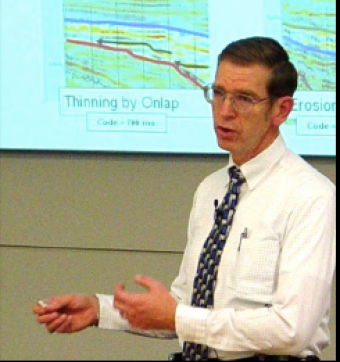50min Advanced
This lesson explains what petroleum geoscientists mean by a well-seismic tie and what purposes it serves. Wells are in units of ft or m along the borehole with zero set at the kb (Kelly Bushing). For pure vertical wells, log depths are vertical depths. For deviated wells, we have to correct measured depths to true vertical depth. However, seismic data are processed to a “seismic reference datum”. All marine surveys are datumed to sea level. Coastal surveys are usually datumed to sea level. Inland surveys are datumed to an elevation higher than the highest topographic point in the survey area (e.g., a survey near Denver might be datumed to 5500 ft). Thus, there are difficulties when considering the information together.
The class should be divided into three (3) segments. The first should be a review of the previous exercise (Exercise 14), followed by an introduction to the lecture material and the exercise. The review of Exercise 14 has eight (8) slides, and will take ~10 minutes to explain. The lecture material presented here has fifteen (15) slides, and will take ~30 minutes to explain. The introduction to the exercise has five (5) slides, and will take ~10 minutes to explain. In total, the class time will take ~50 minutes.
The exercise is a well-seismic tie from an area onshore the United States. In the solution for the exercise, show the well tie for the Barracouta-1 well. This well tie is not simple, hence the switch of study area. The exercise instructions should be easy to follow. If the instructor has time during the class period, walk them through the tie of the top of Buda. It should take no more than twenty (20) minutes to complete this exercise.
At the end of this lesson, students should be able to:

This course, based on teaching material from Dr. Fred Schroeder (formerly of Exxon/ExxonMobil), reflects on the geology and geophysics basics for the petroleum industry. General geology and basic geophysics are not required, but helpful with the material.
We encourage the reuse and dissemination of the material on this site as long as attribution is retained. To this end the material on this site, unless otherwise noted, is offered under Creative Commons Attribution (CC BY 4.0) license